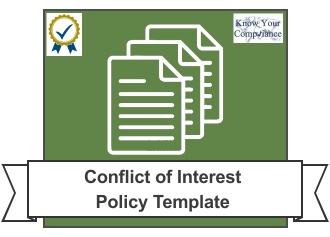Conflict of Interest Policy Template
What is a Conflict of Interest?
![]() A conflict of interest as it relates to business, is defined as an action or relationship that may impair the ability to make an objective and/or fair decision. This conflict can arise from the impairment of an individual employee or as a business activity. A conflict of interest in a financial firm is defined as an employee or the firm itself having a financial interest in a client or business activity with which it is involved, resulting in the potential compromise of the advice, products or services provided, to the detriment of the client.
A conflict of interest as it relates to business, is defined as an action or relationship that may impair the ability to make an objective and/or fair decision. This conflict can arise from the impairment of an individual employee or as a business activity. A conflict of interest in a financial firm is defined as an employee or the firm itself having a financial interest in a client or business activity with which it is involved, resulting in the potential compromise of the advice, products or services provided, to the detriment of the client.
Financial conflicts of interest are seen to be tangible, because they can be seen and measured, however this is not always the case and so it is important for firms to put controls, systems and procedures into place to assess, identify, manage and monitor conflicts of interest.
Writing a Conflict of Interest (COI) Policy
There are a number of objectives that should be included in a COI Policy, aimed at providing a working document for employees and third parties in how the organisations handles conflicts and what tools and monitoring processes they have in place.
Examples of the objectives a firm should include in their Conflict of Interest Policy include (but are not limited to): –
- Ensuring clear procedures are in place for identifying and managing conflicts of interest
- Maintaining accurate and up to date records of any conflicts
- Ensuring that clients are provided with all the information relevant to them to allow an informed decision (including any possible risks, adverse effects or possible conflicts)
- Ensuring compliance with any conflict of interest requirements/obligations under The Money Laundering Regulations 2017 (inc. 2019/2020 amendments)
- Having compliant policies in place for Renumeration, Whistleblowing and Anti-Bribery & Corruption (including gifts, entertainment and hospitality)
Types of Conflict of Interest
To ensure a COI Policy is effective, it is important for organisations to understand the different types of conflict of interest. This can be done by assessing the organisation and its employees to see if: –
- They are likely to make a financial gain, or avoid a financial loss, at the expense of the client
- They have an interest in the outcome of a service provided to the client, or of a transaction carried out on behalf of the client, which is distinct from the client’s interest in that outcome
- They have a financial or other incentive to favour the interest of another client or group of clients over the interests of the client
- The firm carries on the same business as the client
- They receive (or will receive) from a person other than the client, an inducement in relation to a service provided to the client, in the form of monies, goods or services, other than the standard commission or fee for that service
Conflict of Interest Procedures
 There are a number of processes and measures that organisations can put into place to mitigate or monitor conflicts of interest. These include robust disclosure requirements with all clients and third-parties.
There are a number of processes and measures that organisations can put into place to mitigate or monitor conflicts of interest. These include robust disclosure requirements with all clients and third-parties.
An effective renumeration policy with clear procedures is essential. Effective anti-bribery and corruption obligations and responsibilities with regard to hospitality, gifts and entertainment and controlling information barriers.
Conflict of Interest Policy Template
Thousands of organisations already use our compliance policy templates to enhance their existing compliance program and to save time and money when drafting or updating policy content. If your organisation has an obligation to implement a Conflict of Interest Policy or you are looking to update your current version, our COI Policy Template also comes with a COI Register template and the option to fully customise and corporate brand your document.
Conflict of Interest Policy
